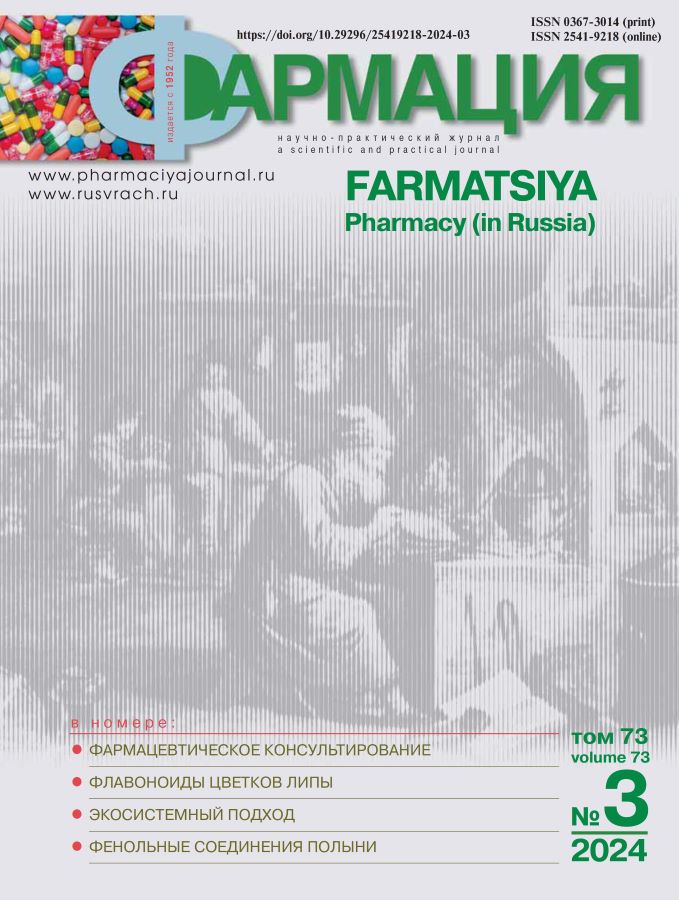Profile of phenolic compounds of the herb of some species of the genus Artemisia L.
- Authors: Romanteeva Y.V.1
-
Affiliations:
- Saratov State Medical University named after V.I. Razumovsky
- Issue: Vol 73, No 3 (2024)
- Pages: 5-9
- Section: Pharmaceutical chemistry and pharmacognosy
- URL: https://journals.eco-vector.com/0367-3014/article/view/633220
- DOI: https://doi.org/10.29296/25419218-2024-03-01
- ID: 633220
Cite item
Abstract
Introduction. One of the promising directions in the intensively developing pharmaceutical industry is the study of wild plants closely related to pharmacopoeial species in order to expand the raw material base of medicinal plants. In this aspect, the genus Artemisia L., which is one of the numerous species in the family Asteraceae, is of interest. There are about 800 species of Artemisia in the world flora. Plants of the genus Artemisia L. contain secondary metabolites of various chemical structures, of which phenolic compounds are one of the leading groups. In the Saratov region plants of this genus are poorly studied in terms of chemical composition.
Objective: comparative study of chromatographic profile of extracts of above-ground parts of non-pharmacopoeial Artemisia species growing in Saratov region.
Material and methods. The objects of the study were samples of herbs of A. austriaca Jacq., A. marschalliana Spreng., A. santonica L., А. dracunculus L. collected in 2021 in the Saratov region during the period of mass flowering. Thin-layer chromatography of the extracts was carried out in the solvent system: ethyl acetate – anhydrous methanoic acid – purified water (40:4:6). The adsorption zones were detected by UV light after sequential treatment with 1% solution of diphenylboronic acid aminoethyl ether alcoholic solution and 5% solution of macrogol 400 alcoholic solution.
Results. Chromatographic profiles of extracts of four species of Artemisia growing in the Saratov region were obtained. The study revealed both similarities and differences in the values of retention factors, colouring, intensity of adsorption zones of the tested extracts.
Conclusion. The experimental data obtained represent practical interest in establishing the authenticity of these wormwood species, as well as in standardisation of pharmaceutical phytosubstances based on them.
Full Text
About the authors
Yuliya Viktorovna Romanteeva
Saratov State Medical University named after V.I. Razumovsky
Author for correspondence.
Email: yuliyarom81@mail.ru
ORCID iD: 0000-0002-0048-9630
PhD in Pharmaceutical Sciences, Associate Professor at the Department of General Biology, Pharmacognosy and Botany
Russian Federation, SaratovReferences
- Bora K.S., Sharma A. The genus Artemisia: a comprehensive review. Pharm. Biol. 2011; 49 (1): 101–9. doi: 10.3109/13880209.2010.497815.
- Буданцев А.Л. Растительные ресурсы России. Дикорастущие цветковые растения, их компонентный состав и биологическая активность. Семейство Asteraceae (Compositae). Роды Achillea–Doronicum. СПб.: М.: Товарищество научных изданий КМК, 2012; 5 (1): 320. [Budancev A.L. Rastitel'nye resursy Rossii. Dikorastushhie cvetkovye rastenija, ih komponentnyj sostav i biologicheskaja aktivnost'. Semejstvo Asteraceae (Compositae). Rody Achillea–Doronicum. SPb: M.: Tovarishhestvo nauchnyh izdanij KMK, 2012; 5 (1): 320 (in Russian)]
- Маевский П.Ф. Флора средней полосы европейской части России: 11-е изд. М.: Товарищество научных изданий КМК, 2014; 364–8. [Maevskiу P.F. Flora of the middle zone of the European part of Russia. Moscow: Tovarishhestvo nauchnyx izdaniу KMK, 2014; 364–8 (in Russian)]
- Архипова Е.А., Афанасьева Н.А., Волков Ю.В. Распространение видов рода Artemisia L. на территории Саратовской области по материалам гербария СГУ (SARAT). Международная научно-практическая конференция, посвященная 132-ой годовщине со дня рождения академика Н.И. Вавилова. «Вавиловские чтения – 2019». Саратов: Амирит, 2019; 250–2. [Arhipova E.A., Afanas'eva N.A., Volkov Ju.V. Rasprostranenie vidov roda Artemisia L. na territorii Saratovskoj oblasti po materialam gerbarija SGU (SARAT). Mezhdunarodnaja nauchno-prakticheskaja konferencija, posvjashhennaja 132-oj godovshhine so dnja rozhdenija akademika N.I. Vavilova. «Vavilovskie chtenija – 2019». Saratov: Amirit, 2019; 250–2 (in Russian)]
- Государственный реестр лекарственных средств. ГРЛС. [Электронный ресурс]. URL: https://grls.rosminzdrav.ru/ [Gosudarstvennyi reestr lekarstvennykh sredstv. GRLS. [Elektronnyi resurs]. Access mode: https://grls.rosminzdrav.ru/. (in Russian)]
- Bisht D., Kumar D., Kumar D. et al. Phytochemistry and pharmacological activity of the genus Artemisia. Archives of Pharmacal Research. 2021; 44 (5): 439–74. doi: 10.1007/s12272-021-01328-4.
- Куркина А.В. Флавоноиды фармакопейных растений: монография. Самара, 2012; 290. [Kurkina A.V. Flavonoidy farmakopeinykh rastenii: monografiya. Samara, 2012; 290 (in Russian)]
- Морозов C.B., Ткачева Н.И., Ткачев A.B. Проблемы комплексного химического профилирования лекарственных растений. Химия растительного сырья. 2018; 4: 5–28. doi: 10.14258/jcprm.2018044003. [Morozov C. B., Tkacheva N. I., Tkachev A. B. Problems of integrated chemical profiling of medicinal plants. Khimiya rastitel'nogo syr'ya. 2018; 4: 5–28. doi: 10.14258/jcprm.2018044003 (in Russian)]
- Тринеева О.В., Рудая М.А., Сливкин А.И. Исследование профиля флавоноидов плодов облепихи крушиновидной различных сортов методом тонкослойной хроматографии. Сорбционные и хроматографические процессы. 2020; 20 (1): 79–86. doi: 10.17308/sorpchrom.2020.20/2382. [Trineeva O.V., Rudaya M.A., Slivkin A.I. Study of flavonoid profile of sea buckthorn fruits of different varieties by thin layer chromatography. Sorbtsionnye i khromatograficheskie protsessy. 2020; 20 (1): 79–86. doi: 10.17308/sorpchrom.2020.20/2382. (in Russian)]
- Шестопалова Н.Б., Фомина Ю.А. Фенольные соединения Gleditsia triacantos L., произрастающей на территории Саратовской области. 90 лет – от растения до лекарственного препарата: достижения и перспективы. Сборник материалов юбилейной международной научной конференции. Федеральное государственное бюджетное научное учреждение «Всероссийский научно-исследовательский институт лекарственных и ароматических растений». 2021; 493–8. doi: 10.52101/9785870191003_2021_493. [Shestopalova N.B., Fomina Yu.A. Phenolic compounds of Gleditsia triacantos L. growing in the territory of the Saratov region. 90 let – ot rasteniya do lekarstvennogo preparata: dostizheniya i perspektivy. Sbornik materialov yubileinoi mezhdunarodnoi nauchnoi konferentsii. Federal'noe gosudarstvennoe byudzhetnoe nauchnoe uchrezhdenie «Vserossiiskii nauchno-issledovatel'skii institut lekarstvennykh i aromaticheskikh rastenii». 2021; 493–8. doi: 10.52101/9785870191003_2021_493 (in Russian)]
- Государственная фармакопея Российской Федерации. XIV изд., том IV. [Электронное издание]. Режим доступа: https://femb.ru/record/pharmacopea14. [Дата обращения 20 августа, 2023]. [The State Pharmacopoeia of The Russian Federation, XIV ed., volume IV, Moscow: ». [Electronic edition]. Access mode: https://femb.ru/record/ pharmacopea14 [Accessed 20 August, 2023] (in Russian)]
- Wagner H., Bladt S., Rickl V. Plant Drug Analysis. A Thin Layer Chromatography Atlas. Springer, 2001; 384.
- Кирхнер Ю. Тонкослойная хроматография. М.: «Мир», 1981; 402–7. [Kirkhner Yu. Tonkosloinaya khromatografiya. M.: «Mir», 1981; 402–7 (in Russian)]
- Гейсс Ф. Основы тонкослойной хроматографии. М.: «Мир», 1999; 405. [Geiss F. Osnovy tonkosloinoi khromatografii. M.: «Mir», 1999; 405 (in Russian)]
Supplementary files







